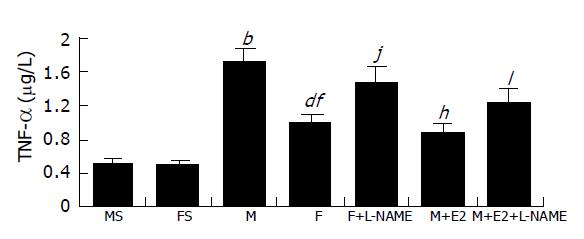Copyright
©2005 Baishideng Publishing Group Inc.
World J Gastroenterol. Jun 14, 2005; 11(22): 3441-3445
Published online Jun 14, 2005. doi: 10.3748/wjg.v11.i22.3441
Published online Jun 14, 2005. doi: 10.3748/wjg.v11.i22.3441
Figure 2 Serum TNF-α levels (n = 6, mean±SD).
No significant differences existed between MS and FS groups with respect to serum TNF-α levels. Serum TNF-α levels increased significantly after hepatic I/R in M or F group vs MS or FS group (bP<0.01 or dP<0.01, respectively), but they were significantly lower in F group vs M group rats (fP<0.01). When compared with male rats pretreated with saline (M group), pretreatment of male rats with E2 (M+E2 group) significantly decreased serum TNF-α levels after hepatic I/R (hP<0.01). Pretreatment with L-NAME in female rats or co-pretreatment with E2 and L-NAME in male rats significantly increased serum TNF-α levels vs those in F or M+E2 group animals, respectively, after hepatic I/R (jP<0.01 or lP<0.01).
- Citation: Lü P, Liu F, Wang CY, Chen DD, Yao Z, Tian Y, Zhang JH, Wu YH. Gender differences in hepatic ischemic reperfusion injury in rats are associated with endothelial cell nitric oxide synthase-derived nitric oxide. World J Gastroenterol 2005; 11(22): 3441-3445
- URL: https://www.wjgnet.com/1007-9327/full/v11/i22/3441.htm
- DOI: https://dx.doi.org/10.3748/wjg.v11.i22.3441









